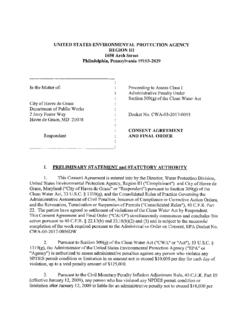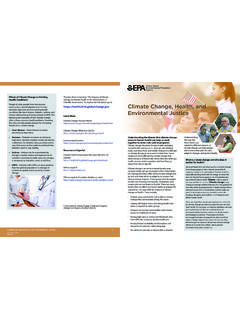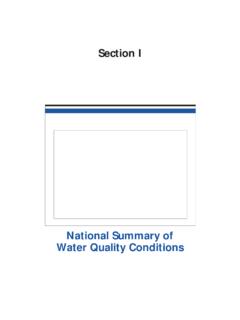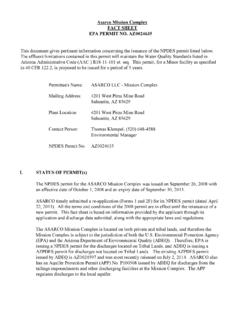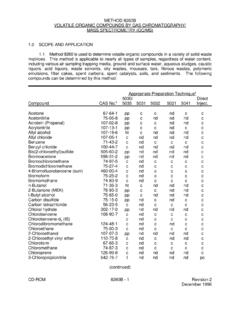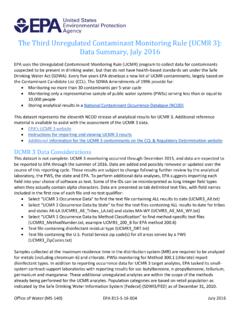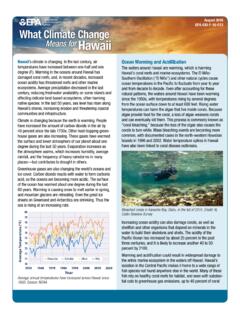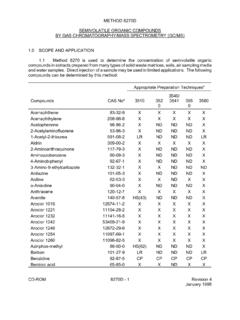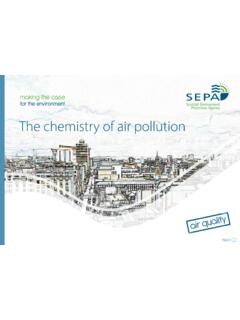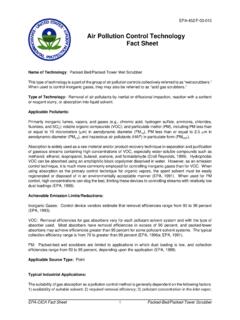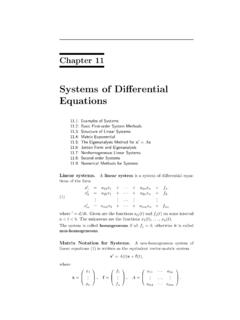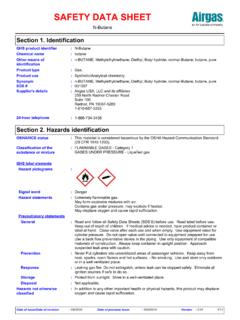Transcription of 1. INTRODUCTION 1.1 PROBLEM STATEMENT
1 1 1. INTRODUCTION PROBLEM STATEMENT The purpose of this project is to identify the effect that surface modifications have on the urban heat island phenomenon and related ozone PROBLEM in the metropolitan area of Chicago, IL. The basic hypothesis is that urban, summertime temperatures can be significantly lowered by increasing the vegetative landscape cover and enhancing the solar reflectivity of paved and roofed surfaces within an urban area. It is proposed that in addition to a decrease in temperature, the modification of an urban surface to include more vegetative cover and lighter, lower albedo surfaces will also reduce energy consumption, ozone exceedances, and detrimental environmental and human health effects associated with high levels of ozone. The analysis is divided into three main parts. The first section of this report introduces the causes of ground level ozone and its effects in urban areas.
2 It explains both the chemistry and transport associated with ozone exceedances. The second section is a compilation of the most viable mitigation strategies of urban heat islands: increasing vegetative cover and increasing proportions of light to dark surfaces. The effects, implementation strategies, and specific strengths and weaknesses associated with each approach are described, including a comparison of asphalt and concrete pavements systems using a life cycle analysis approach. The final section provides a case study of the Chicago area. This study entailed an examination of the land use, development of an urban fabric analysis in which total vegetative, paved, and roofed surfaces are investigated and quantified, and discussion on the effectiveness of possible mitigation strategies in the Chicago area. In general, the associated findings of my research are located within this final section.
3 2 OBJECTIVES The overall goal of this project is to investigate the relationship between the urban heat island phenomenon, the ozone PROBLEM , and the effect of urban surface cover and color modifications in the metropolitan area of Chicago, IL. The specific objectives of this work are to: Review the detrimental effects of the urban heat island phenomenon, particularly as a causative factor in promoting exceedances of air quality ozone standards, and identify mitigation alternatives that may reduce the effects of the urban heat island. Illustrate the differences in temperature between the urbanized center of Chicago and the surrounding areas in order to identify the heat island in the Chicago region. Examine the spatial distribution of ozone levels in the Chicago area and consider probable sources. Evaluate of the relationship between temperature and ozone.
4 Develop a method to analyze the urban fabric of the Chicago area from aerial photographs, thus allowing the determination of the proportion of vegetative, roofed, and paved surfaces as a function of land use. Evaluate of the effectiveness of possible mitigation strategies as applied to the Chicago area, with special focus on vegetation and paving materials. 3 2. BACKGROUND THE URBAN HEAT ISLAND Over the past century, there has been an increasing trend towards urbanization. In 1900, approximately 150 million people lived in urban areas with populations of 20,000 or more. This was less than 10% of the world s population. Today this population has grown to approximately billion, which constitutes close to 50% of the world's population.(1) In the United States today, roughly 80% of the people reside in metropolitan areas.(2) High rates of urbanization have resulted in drastic demographic, economic, land use, and climate changes.
5 The growth and expansion of our urban centers entail the construction of new roads, buildings, and other various human made structures to accommodate the growing population, and in turn, the destruction of the natural ground cover and landscape. This urbanization of the natural landscape can have profound meteorological impacts causing urban microclimates, referred to as urban heat islands, with elevated air temperatures of 2-8 F, increased energy demands, and elevated pollution concentrations compared to rural surrounding areas.(3) Figure 1 provides an illustration of a typical heat island profile for a metropolitan area. Figure 1 Source: Cooling Our Communities, USEPA (3) 4 While, most cities today exhibit heat island effects relative to predevelopment conditions, their individual intensities depend on a number of factors: geography, topography, land use, population density, and physical layout.
6 Urban heat islands are exacerbated by the loss of vegetation combined with the large quantities of low albedo surfaces, such as dark paving and roofing materials in urban areas. Vegetative cover, which includes trees, shrubs, and other plants, not only provides shade for buildings by intercepting solar radiation, but can cool the air by the evapotranspiration of absorbed ground water through its leaves. When this vegetative cover is destroyed, it is usually replaced by either pavement or buildings, which results in not only the loss of beneficial cooling mechanisms but the addition of detrimental heating effects. These detrimental heating effects are related to the albedo and emissivity of the paving and roofing materials utilized in the construction. Most of materials used in construction produce low albedo and low emissive surfaces. Low albedo surfaces have low reflectivity, and consequently absorb solar radiation, instead of reflecting it back into space.
7 Low emissive surfaces release this trapped heat energy slowly, thus causing the cooling process to progress at a slow rate also. These combined properties may result in an increase in the temperature of the surfaces, as much as 85 F above the ambient air temperature (4), which can sustain high temperatures into the night. For example, on a 90 F day, a dark asphalt parking lot surface can heat up to a temperature of 175 F. When the sun sets, the pavement surface will slowly begin to release the stored heat energy it accumulated throughout the day. However, as the pavement starts to cool off, the air around the surface begins to heat up, consequently maintaining elevated temperatures into the night. Thus, the thermal processes active in a heat island begin with the sunrise in the early morning, continue throughout the day, and often persist into the night.
8 5 The heating of urban areas has serious consequences that can effect both human health and the environment. Elevated temperatures can result in the degradation of urban air quality due to an increase in the rate of the formation of ground level ozone, which is the principal component of photochemical smog and the primary component of concern related to the heat island effect. The higher temperatures also create increased energy use, which is primarily due to a greater demand for air conditioning, for prolonged periods of time. It is estimated that for cities with populations larger than 100,000 people, peak utility loads will increase to 2% for every 1 F increase in temperature.(3) Thus, as power plants burn more fossil fuels to meet the increase in energy demand, they also drive up both energy costs and pollution levels which may eventually lead to increased ozone production.
9 In fact, one sixth of the electricity currently consumed in the United States goes to cool buildings, at an annual power cost of $40 billion.(4) There are various ways of combating the urban heat island effect. One strategy is to increase the vegetative cover in urban areas so as to reestablish the beneficial cooling effects associated with it. Another strategy is to implement the use of lighter, high albedo materials for pavement and roofs. More reflective, cooler pavements have benefits in addition to reduced energy and photochemical smog. The use of cooler pavements can lead to longer pavement lifetimes, for high albedo pavement is less likely to be softened and damaged at high temperatures. In addition, at night, lighter pavements will reflect more light onto pedestrians and signs, helping to avoid accidents. AIR QUALITY IN URBAN AREAS GROUND LEVEL OZONE Ozone (O3) is a reactive oxidant gas produced naturally in trace amounts in the earth s atmosphere, and, depending upon its location in the atmosphere, ozone can be good or bad.
10 The majority of the earth s atmospheric ozone, approximately 90%, is found in the stratosphere, 6 where it acts as a protective layer absorbing harmful ultraviolet radiation emitted by the sun and preventing it from reaching the earth s surface. The remaining 10% of the earth s ozone is located in the troposphere and is often referred to as ground level ozone. Here ozone exists as the primary ingredient in photochemical smog and has detrimental effects on human health and the environment. Smog, traditionally defined as the combination of smoke and fog, is produced when both primary and secondary gaseous, aerosol, and particulate pollutants get trapped in the air. Primary air pollutants, such as carbon monoxide (CO), carbon dioxide (CO2), sulfuric dioxide (SO2), nitrous oxide (NO), suspended particulate matter, and hydrocarbons (volatile organic compounds), are substances released directly into the atmosphere.

